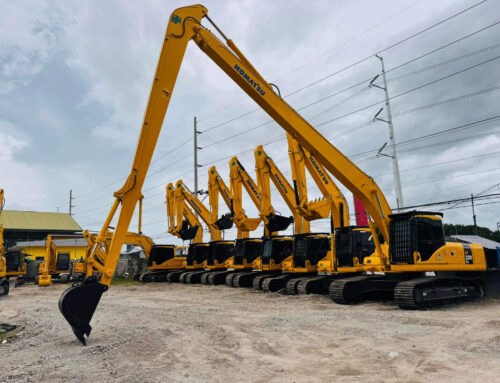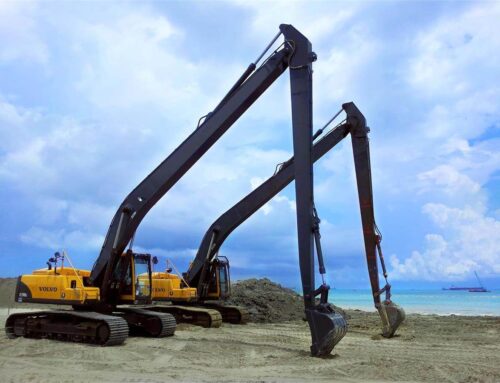Komatsu excavators are renowned for their reliability, power, and versatility in various construction and mining applications. However, like any heavy machinery, they are not without their challenges, especially when equipped with a long front boom. The long front boom is designed to extend the reach of the excavator, allowing it to perform tasks such as deep digging, long reach excavation, and demolition work. While this attachment significantly enhances the machine’s capabilities, it also introduces several potential problems and failures. In this blog post, we will delve into six common issues associated with the long front boom for the Komatsu excavators and provide practical solutions to mitigate these challenges.
-
Long Front Boom for the Komatsu Excavators Structural Fatigue and Cracking
Problem:
One of the most critical issues with the long front boom for the Komatsu excavators is structural fatigue and cracking. The extended length of the boom subjects it to increased stress and strain, especially during heavy lifting or repetitive operations. Over time, this can lead to the development of cracks in the boom structure, which can compromise the excavator’s safety and functionality.
Solution:
Regular inspections are crucial to detect early signs of structural fatigue. Operators and maintenance personnel should closely monitor the boom for any visible cracks or signs of wear. Implementing a routine inspection schedule and using non-destructive testing methods, such as ultrasonic testing or magnetic particle inspection, can help identify hidden cracks. Additionally, reinforcing high-stress areas with additional steel plating or gussets can provide extra strength and durability to the boom.
-
Long Front Boom Komatsu Excavators Hydraulic System Failures
Problem:
The hydraulic system is the lifeblood of any excavator, and the long front boom for the Komatsu excavators places additional demands on this system. Hydraulic hoses and fittings are more prone to leaks and failures due to the increased reach and movement of the boom. A hydraulic failure can lead to downtime and costly repairs.
Solution:
To prevent hydraulic system failures, it’s essential to use high-quality hydraulic hoses and fittings designed to withstand the demands of the long front boom. Regularly inspect all hydraulic components for signs of wear, leaks, or damage. Implementing a preventative maintenance schedule that includes changing hydraulic fluids and filters at recommended intervals will help keep the system in optimal condition. Moreover, training operators to use the boom within its specified limits can reduce unnecessary strain on the hydraulic system.
-
Long Front Boom for the Komatsu Excavators Boom Drift and Stability Issues
Problem:
The extended reach of the long front boom for the Komatsu excavators can cause stability issues, particularly when working at full extension. Boom drift, where the boom slowly moves out of position even when controls are not engaged, can occur due to hydraulic leaks or wear in the boom cylinders. Stability issues can lead to unsafe working conditions and reduced precision in operations.
Solution:
To address boom drift, ensure that all hydraulic cylinders are in good condition and free from internal leaks. Regularly check and replace worn seals and gaskets in the hydraulic cylinders. Installing boom locks or additional stabilization mechanisms can enhance stability during operations. Training operators to understand the limits of the boom and avoid working at maximum extension whenever possible can also improve stability and safety.
-
Increased Wear on Pivot Points and Bushings
Problem:
The long front boom introduces increased wear on pivot points and bushings due to the extended leverage and movement. This wear can lead to excessive play in the boom, reduced precision, and eventually, failure of these components.
Solution:
Implement a strict lubrication schedule to ensure that all pivot points and bushings are adequately lubricated to minimize friction and wear. Using high-quality, heavy-duty greases designed for extreme conditions can prolong the life of these components. Regularly inspect and replace worn pivot pins and bushings to maintain tight tolerances and prevent excessive play in the boom.
-
Overloading and Tipping Hazards
Problem:
The long front boom for the Komatsu excavators allows for deeper digging and higher reach, but it also increases the risk of overloading and tipping the excavator. Operators may inadvertently exceed the machine’s lifting capacity, leading to dangerous tipping situations and potential equipment damage.
Solution:
Provide comprehensive training to operators on the safe use of the long front boom, emphasizing the importance of adhering to the machine’s load capacity limits. Use load monitoring systems and alarms to alert operators when they are approaching or exceeding safe load limits. Additionally, installing counterweights and using outriggers or stabilizers can enhance the machine’s stability and reduce the risk of tipping.
-
Komatsu Excavators Long Front Boom Reduced Precision and Control
Problem:
The increased length and leverage of the long front boom can reduce the precision and control of the excavator, making it challenging to perform delicate tasks or operate in confined spaces. This can lead to inefficiencies and increased cycle times.
Solution:
Equip the excavator with advanced control systems that offer precise and responsive handling of the boom. Hydraulic systems with fine control capabilities, such as load-sensing hydraulics or electronic pilot controls, can improve the operator’s ability to perform precise movements. Training operators to use these control systems effectively and to plan their movements carefully can enhance precision and overall productivity.
Conclusion
While the long front boom for the Komatsu excavators significantly extends their operational capabilities, it also introduces several potential problems and failures. Addressing these challenges requires a combination of regular maintenance, operator training, and the use of high-quality components. By implementing the solutions outlined above, operators and maintenance personnel can ensure the safe and efficient use of the long front boom, maximizing the excavator’s productivity and minimizing downtime. Regular inspections, proactive maintenance, and adherence to operational limits are key to overcoming the challenges associated with the long front boom and keeping Komatsu excavators performing at their best.







Leave A Comment